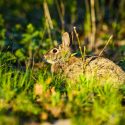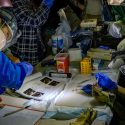Watch: Getting hands-on with wildlife
Students at the University of Wisconsin–Madison’s School of Veterinary Medicine brought their skills out of the classroom and into the treatment room this summer thanks to a wildlife clinical rotation.
Taught by clinicians from the Zoological Medicine service, the rotation partners with wildlife centers around the state, including the Dane County Humane Society (DCHS) and the Wisconsin Humane Society in Milwaukee. Students get the opportunity to see, treat and ultimately help rehabilitate animals for release back into the wild.
“Our goal is to immerse them in wildlife medicine and get them really passionate about that, so that there are more veterinarians that are able and willing to see wildlife,” says Shawna Hawkins, one of the program’s veterinarians.
Students realized they could use their knowledge to help animals who may otherwise have no one to look out for them.
“It’s really cool to be the voice of reason and make sure they’re getting the care that they need,” says Ali Sturtecky, a second-year student who participated in the rotation.
Needing to know the anatomy and physiology of a variety of different species is part of being a veterinarian, but the need is especially true in wildlife medicine. And it’s more than knowing the differences between treating cats and dogs.
In a single day, Hawkins and the students treated a tree frog, a turtle, two crows, a pelican and a toad.
“I learned about things like turtle shell repair, orthopedic surgery in birds — things that I never would have expected to have the opportunity to learn so early in my veterinary career,” says Nandita Chittajallu, also a second-year student.
Sturtecky and Chittajallu were joined by fourth-year Samantha Oldenburg for a two-week rotation with Hawkins and the staff at the DCHS Wildlife Center. Throughout the rotation, the students went from shadowing Hawkins and veterinary technician Erin Lemley to taking an active role in assessing and proposing treatment plans with their instructors.
“It was really cool to feel like the doctor and not just be sitting in class or standing in the background,” says Sturtecky.
She says being in such a safe and comfortable environment helped her feel confident in recognizing when she needed to ask for help, so she could learn more and then create a treatment plan.
Students are usually very nervous when they start the rotation.
“Just because it’s wild doesn’t mean the medicine is wildly different,” Hawkins says. “An opossum is still a mammal, so let’s talk about what you would do in dogs and cats and extrapolate and talk about what would be appropriate for this opossum.”
Seeing how quickly the students grow and the confidence they gain in such a short amount of time is one of Hawkins’ favorite parts of teaching. By the end of the rotation, every student knew they wanted to be able to incorporate wildlife medicine into their practice after graduating.
“This has helped me grow as a veterinary student in a lot of different ways,” Chittajallu says. “I saw so many interesting cases that I believe are going to give me a leg up for future years of veterinary school. And I’m so excited to continue on this career path.”



